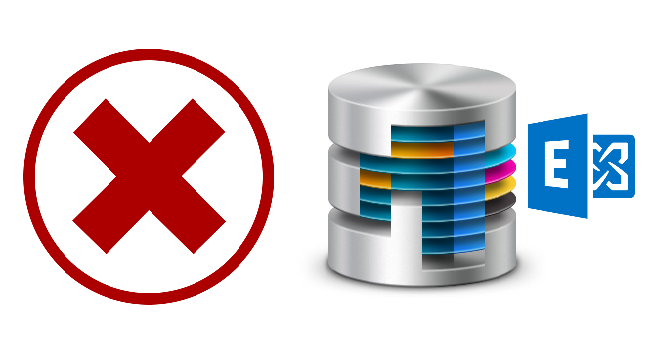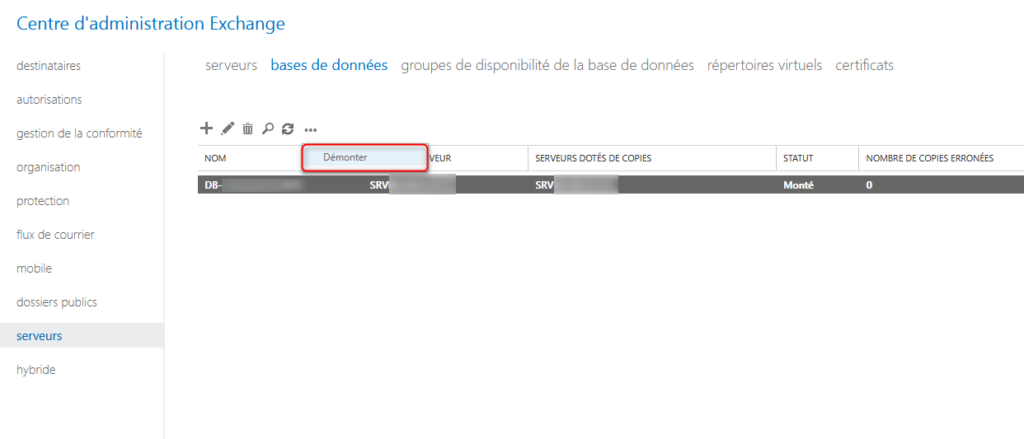
This mailbox database contains one or more mailboxes, mailbox plans, archive mailboxes, public folder mailboxes or arbitration mailboxes
17 June 2021Error :
“This mailbox database contains one or more mailboxes, mailbox plans, archive mailboxes, public folder mailboxes or arbitration mailboxes, audit mailboxes. To get a list of all mailboxes in this database, run the Get-Mailbox -Database <database ID> command. To get a list of all mailbox plans in this database, run the Get-MailboxPlan command. To get a list of archive mailboxes in this database, run the Get-Mailbox -Database <database ID> -Archive command. For a list of all public folder mailboxes in this database,run the Get-Mailbox -Database <database ID> -PublicFolder command. To get a list of all arbitration mailboxes in this database, run the Get-Mailbox -Database <database ID> -Arbitration command. To get a list of all audit mailboxes in this database, run the Get-Mailbox -Database <database ID> -AuditLog command. To disable a mailbox without arbitration so that you can drop the mailbox database, run the Disable-Mailbox <Mailbox ID> command. To disable an archive mailbox so that you can delete the mailbox database, run the Disable-Mailbox <Mailbox ID> -Archive command.To deactivate a public folder mailbox so that you can delete the mailbox database, run the Disable-Mailbox <Mailbox ID> -PublicFolder command. To disable an audit mailbox so that you can delete the mailbox database, run the command Get-Mailbox -AuditLog | Disable-Mailbox. Arbitration mailboxes must be moved to another server; to do this, run the New-MoveRequest <parameters> command. If this is the last server in the organization, run the Disable-Mailbox <Mailbox ID> -Arbitration -DisableLastArbitrationMailboxAllowed command to disable the arbitration mailbox. Mailbox plans must be moved to another server; for it,run the command Set-MailboxPlan <MailboxPlan ID> -Database <Database ID>. “
This will allow you to see the objects throughout the forest
|
1 |
Set-ADServerSettings -ViewEntireForest $true |
Check the status of the mailbox database.
Run the Get-MailboxDatabase cmdlet.
|
1 2 3 4 5 6 |
Get-MailboxDatabase -Status | Sort Name | Format-Table Name, Server, Mounted Name Server Mounted ---- ------ ------- DB01 SRVEX01-2016 True DB02 SRVEX01-2016 True |
Run Get-Mailbox to find all the mailboxes in the database that you are going to delete.
|
1 2 3 4 5 6 7 8 |
Get-Mailbox -Database "DB01" Name Alias ServerName ProhibitSendQuota ---- ----- ---------- ----------------- Administrateur Administrateur srvex01-2016 Unlimited DiscoverySearchMailbox... DiscoverySearchMa... srvex01-2016 Unlimited CHADER RACHED chader.rached srvex01-2016 Unlimited jenfile desperles jenfile.desperles srvex01-2016 Unlimited |
Move all mailboxes from one database to another with the New-MoveRequest cmdlet.
|
1 2 3 4 5 6 7 8 |
Get-Mailbox -Database "DB01" -ResultSize Unlimited | New-MoveRequest -TargetDatabase "DB02" DisplayName StatusDetail TotalMailboxSize TotalArchiveSize PercentComplete ----------- ------------ ---------------- ---------------- --------------- Administrateur WaitingForJobPickup 695.9 KB (712,591 bytes) 0 Discovery Search Mailbox WaitingForJobPickup 0 B (0 bytes) 0 CHADER RACHED WaitingForJobPickup 23.66 MB (24,812,530 bytes) 0 jenfile desperles WaitingForJobPickup 154.6 MB (162,135,858 bytes) 0 |
Find the archive mailboxes in the database.
|
1 |
Get-Mailbox -Database "DB01" -Archive |
Move the archive mailboxes to another database.
|
1 |
Get-Mailbox -Database "DB01" -Archive | New-MoveRequest -TargetDatabase "DB02" |
Find the public folder mailboxes in the database.
|
1 |
Get-Mailbox -Database "DB01" -PublicFolder |
Move the public folder mailboxes to another database.
|
1 |
Get-Mailbox -Database "DB01" -PublicFolder | New-MoveRequest -TargetDatabase "DB02" |
Find arbitration mailboxes in the database.
|
1 2 3 4 5 6 7 8 9 10 11 |
Get-Mailbox -Database "DB01" -Arbitration Name Alias ServerName ProhibitSendQuota ---- ----- ---------- ----------------- SystemMailbox{1f05a927... SystemMailbox{1f0... srvex01-2016 Unlimited SystemMailbox{bb558c35... SystemMailbox{bb5... srvex01-2016 Unlimited SystemMailbox{e0dc1c29... SystemMailbox{e0d... srvex01-2016 Unlimited Migration.8f3e7716-201... Migration.8f3e771... srvex01-2016 300 MB (314,572,800 bytes) FederatedEmail.4c1f4d8... FederatedEmail.4c... srvex01-2016 1 MB (1,048,576 bytes) SystemMailbox{D0E409A0... SystemMailbox{D0E... srvex01-2016 Unlimited SystemMailbox{2CE34405... SystemMailbox{2CE... srvex01-2016 Unlimited |
Move the arbitration mailbox to another database.
|
1 |
Get-Mailbox -Database "DB01" -Arbitration | New-MoveRequest -TargetDatabase "DB02" |
Find the audit log mailboxes in the database.
|
1 2 3 4 5 |
Get-Mailbox -Database "DB01" -AuditLog Name Alias ServerName ProhibitSendQuota ---- ----- ---------- ----------------- SystemMailbox{8cc370d3... SystemMailbox{8cc... srvex01-2016 50 GB (53,687,091,200 bytes) |
Move the audit log mailboxes to another database.
|
1 |
Get-Mailbox -Database "DB01" -AuditLog | New-MoveRequest -TargetDatabase "DB02" |
Find the monitoring mailboxes associated with the mailbox database.
|
1 2 3 4 5 6 7 8 9 10 11 12 13 14 15 |
Get-Mailbox -Database "DB01" -Monitoring | Format-Table Name, DisplayName, Database, Servername Name DisplayName Database ServerName ---- ----------- ------- ---------- HealthMailbox8ddfa44ce87b470aa29ca09d63014c97 HealthMailbox-srvEX01-2016-005 DB01 srvex01-2016 HealthMailbox217c956c6d8841c8849c3711a53c1548 HealthMailbox-srvEX01-2016-006 DB01 srvex01-2016 HealthMailboxc50946e3d170463e96219bbccf5aa7e4 HealthMailbox-srvEX01-2016-007 DB01 srvex01-2016 HealthMailbox5357efb1fdbe46f38be215864046302b HealthMailbox-srvEX01-2016-008 DB01 srvex01-2016 HealthMailbox63585f5a8b7b4a47a7554c5081fb8cec HealthMailbox-srvEX01-2016-009 DB01 srvex01-2016 HealthMailbox5b4ccf7b5d724fc692a14de58eb9249a HealthMailbox-srvEX01-2016-DB01 DB01 srvex01-2016 HealthMailbox5aa9c931b1d84d51b8b7264a588f07d3 HealthMailbox-srvEX01-2016-001 DB01 srvex01-2016 HealthMailboxf78993a630bb486aaf65a2c51568fb3a HealthMailbox-srvEX01-2016-002 DB01 srvex01-2016 HealthMailboxd0bd623ed7274a9fa8dc23862052bdaf HealthMailbox-srvEX01-2016-003 DB01 srvex01-2016 HealthMailboxeb024a7196dd4d3a9fd9ac13748cd762 HealthMailbox-srvEX01-2016-004 DB01 srvex01-2016 HealthMailbox494bcf084a0e4d9ca46aab4f06ae290e HealthMailbox-srvEX01-2016-010 DB01 srvex01-2016 |
Disable mailbox monitoring.
|
1 |
Get-Mailbox -Database "DB01" -Monitoring | Disable-Mailbox -Confirm:$false |
Check the move request of mailboxes
Verify that all mailboxes are moved. After that, delete the completed move requests. If you don’t, you will get the error.
|
1 |
Get-MoveRequestStatistics -MoveRequestQueue "DB02" |
Delete mailbox move requests
|
1 |
Get-MoveRequest -ResultSize Unlimited | Where-Object {$_.Status -Like "Completed"} | Remove-MoveRequest -Confirm:$false |
If you want to delete all move requests
|
1 |
Get-MoveRequest -ResultSize Unlimited | Remove-MoveRequest -Confirm:$false |
- Sign in to the Exchange admin center.
- Click Servers in the Features pane and click the Databases tab.
- Select the database you want to dismount from the list view.
- Click the More… icon in the toolbar and click Unmount.
A warning will appear if you are sure to delete the database. Click on Yes.
Another warning message indicates that the specified database has been deleted. Note that we need to manually delete the database file from the system.
Start File Explorer on the Exchange server and navigate to the location of the database. Delete the database and the logs folder.
Visits: 5218



